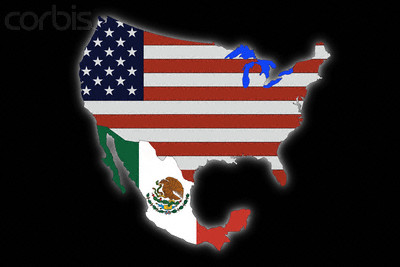
Yesterday, before U.S. Secretary of State Hillary Clinton’s arrival in Mexico the U.S. government announced a package of measures to strengthen security along the shared border, including an impressive increase in the presence of U.S. federal agents in the region; creation of a regional intelligence unit of the Federal Bureau of Investigation (FBI), which will serve as a coordinating center for all Mexico-related activities of the FBI; the outlay of some $700 million in public resources to optimize information exchange between authorities of both countries and the delivery of aircraft for the Mexican Air Force and Navy.
At present, the set of actions does not include the dispatch of U.S. troops to the border, although the head of the U.S. Department of Homeland Security, Janet Napolitano, said that, that possibility is under consideration, a statement with an important change in nuance from the position described on March 11th by President Barack Obama: “I’m not interested in militarizing the border.”
For her part, Mexican Foreign Minister Patricia Espinosa approved the security measures announced by the White House and said that such actions are congruent with the struggle against organized crime. In that regard, it should be remembered that this month, 5,000 troops were deployed to Ciudad Juárez, Chihuahua, before the growing wave of violence in that city.
Militarization of points along the border by the Mexican government and police reinforcement ordered by U.S. authorities across the Rio Grande are not necessarily correct steps in the fight against drug traffic, representing instead bilateral, ambiguous security. After all, the border between the two countries is only one realm of organized criminal activity, a place to gather and express in particularly violent ways the symptoms of a process of social and institutional decomposition much greater than the space on either side of the border itself. The passage of drugs, arms and criminals over the common border is, in effect, the culmination of processes that gestate and develop over time, processes that require attention from both governments in geographic areas far from their common boundary, with spheres of action much broader than police and military.
With these considerations in mind, it can be said that the deployment of a sizeable number of security forces to the region does not, in itself, constitute a blow to the power of drug cartels or their logistic and financial structure; instead, it exposes these troops – civilians and military, and Mexicans and U.S. citizens -to infiltration and bribery by criminal groups.
Furthermore, governments of both countries do not seem to be aware that the measures being discussed involve undesirable risks for the population along the border – the proliferation of annoyances and outrages – already occurring in Mexico. A consequence is the risk of feeding popular animosity against government troops. Moreover, history indicates that circumstances, such as the one under discussion, tend to multiply border incidents, violations of territorial integrity and violations of the sovereignty of countries. It would be particularly disastrous if the actions announced yesterday not only fail to end drug traffic, but give rise to conflicts between elements of the Mexican Army and U.S. security agencies.
In summary, measures announced yesterday by Washington, as well as the satisfaction expressed by the Mexican government, have put in place a flawed security strategy – shared, though it is – to focus on fighting superficial expressions of the complex and deep-rooted problem of drug trafficking. If the goal is eradication of the base of [drug trafficking] and other crimes, then the governments of Calderón and Obama should not focus on police and military pursuit, which so far have proved inefficient. Instead, they should address the social, economic and institutional factors that foster these crimes; undertake effective policies to combat addictions, in order to reduce the demand for illicit drugs; combat the corruption eroding the institutional structure of both countries and, in Mexico, develop and apply a coherent strategy to fight misery, to alleviate poverty and to reduce lacerating social inequality.

Leave a Reply
You must be logged in to post a comment.